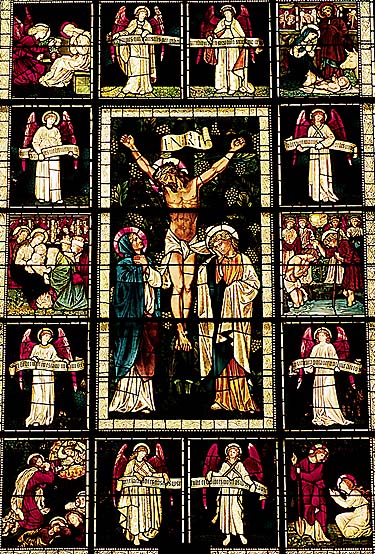![]()
|
The
Vanderpoel Window in The Vanderpoel Window in Trinity Church was part of a donation by the Vanderpoel family to the church in 1874 and is said to represent the first stained glass window commission undertaken by the William Morris company for an American client. The window includes designs by Edward Burne-Jones, Ford Madox Brown and William Morris. The window comprises a central rectangle depicting the Crucifixion with Mary and St John standing on either side. This is surrounded by 14 smaller rectangular panels, 6 depicting New Testament scenes and 8 containing images of angels carrying scrolls bearing latin inscriptions. |
|

|
The central rectangular panel depicts Christ on the cross with the Virgin on the left, looking up, and St John on the right, looking down; all against a vine-patterned background. A. C. Sewter records this design as being based on that which was originally used in St Edmund Hall Chapel, Oxford, in 1865 but I believe that the figure of Christ design was taken from a cartoon by Burne-Jones which was first drawn for Amington in 1864. My opinion is based on what I believe to be closer similarities between the profile of Christ's face, and in particular the shape of His beard on the Amington window and cartoon and the Saugerties window. Also, the scroll bearing the INRI inscription in the cartoon looks almost identical to that in Saugerties. Both the Amington and St Edmund Hall designs feature angels but those at the base are omitted from the cartoon. The cartoon is now in the William Morris museum in Walthamstow and was illustrated in Sewter's book. The Amington window also featured the same figure of Mary as appears in Saugerties as well as the same Nativity and Adoration of the Magi designs. The payment for the Amington Crucifix recorded by Burne-Jones in his accounts book is 8 pounds. The Mary design can also be seen in Haltwhistle (1872), Fochabers (1876) and Thornton (1876).
|
|
The depiction of St John first appeared in St Edmund Hall Chapel, Oxford, in 1865 and can also be seen in Haywards Heath (1867), Haltwhistle (1872), Troutbeck (1873), Brown Edge and Llantrisant (1874), Fochabers and Thornton (1876). Sewter records the Annunciation design by Burne-Jones as having first been used in Brighton in 1865 and then in Coddington (1865) and Haywards Heath (1868) before it's use here in 1874. The Nativity was designed by Burne-Jones for Amington in 1864 and his account book records a payment of 5 pounds for the work. A cartoon for the Nativity is in Birmingham City Art Gallery but is described in the catalogue as 'probably a copy after Burne-Jones by some other hand'. The Adoration of the Magi is another Burne-Jones design which was originally drawn for Amington and his records show that this was also undertaken for the princely sum of 5 pounds. In addition to it's use in Saugerties the design was used in Sunderland and Guernsey (1865), Catton (1866), Haywards Heath (1867) and Bromham (1870). Sewter records that this design was also included in the firm's display in the 1864 Exhibition of Stained Glass at South Kensington in London. This version of the Baptism of Christ by Burne-Jones is said to have been first used in St Edmund Hall Chapel, Oxford, in 1865. The design had also been used in Meole Brace in Staffordshire (1871/2) and Troutbeck (1873). This depiction of the Agony in the Garden was by Ford Madox Brown and was first used in 1872 in Jesus College, Cambridge. In 1874, in addition to it's use in Saugerties, it was also also featured in a memorial window in Newport. Noteworthy is the way Brown captures movement in a way that is very different from Burne-Jones. The image of Christ and Mary Magdelene in the Garden by Burne-Jones first appeared as two tracery lights in Jesus Church, Troutbeck, in 1872. Within the total design there are eight angels holding scrolls inscribed in latin. The designs for these angels are said to be the work of William Morris himself and were originally used for painted ceilings in Jesus College, Cambridge in 1866-67. I hope that you have enjoyed this brief presentation and have found it informative. I have attempted to be as accurate as possible but if there are errors or inaccuracies I apologise. Almost all the background information has been gleaned from A.C. Sewter's "The Stained Glass of William Morris and his Circle, a Catalogue" (Publ Yale 1974-75). |
|